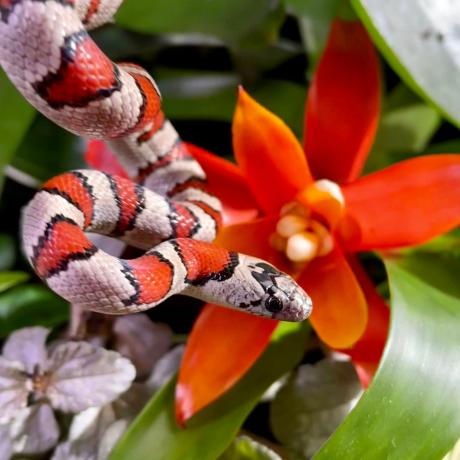

The Durango Kingsnake is also known as a Greer's Kingsnake. They are ideal for beginners due to their calm and docile nature, they are also relatively small for a Kingsnake species.
| Origin | Mexico |
|---|---|
| Environment | Shrubland |
| Adult Size | 2-3ft |
| Suitability | Beginner |
| Lifespan | 10 Years + |
| Temperment | Docile |
The Durango Kingsnake is a small to medium-sized snake reaching an adult length of 2-3ft. They are typical-looking colubrid with a small head and a body which is slightly thicker. The body of the snake is generally grey with black bands with orange and red within the bands.
They have a calm and docile nature, making them ideal for beginners, they are especially good for the younger keeper as they rarely bite or strike out.
Found high up in the mountains of Mexico, primarily the Durango Mountains, it’s easy to see why these snakes prefer cooler temperatures compared to other kingsnake species. With elevations between a staggering 6000-8000ft (1828-2438m) above sea level, snow can often be found on the ground during the colder months.
Their habitat is dry sandy/soil, rocky areas, scrublands, and dry pine forests. Hardy plants like cacti and low shrubs are often found in the mountains. They will generally hide within rock crevices during the daytime heat and venture out when much cooler.
Durango Kingsnakes are one of the easiest species to keep in captivity from our experience. Due to their smaller size and their natural habitat, housing is relatively inexpensive compared to some other species.
Provide a vivarium of at least 3ft in length for a fully grown adult. We always recommend providing a low-level output of UVB lighting as this species requires zone 1 following the Fergurson zone chart.
We would recommend the use of a basking bulb on a dimming thermostat set to reach 27C (80.6F) in the basking area. Do not go any higher as this species can show signs of overheating which in turn will prevent them from feeding, they will cruise the enclosure in a stressed state. Turning the UVB and basking bulb off at night and allowing this to drop down to 18C (64.4F) is perfectly safe for Durango Kingsnakes. Always protect basking bulbs and UVB lighting with a guard to prevent any injury and burns to your snake. Use a digital thermometer or temperature gun to check the temperatures on a regular basis.
Due to their natural habitat, providing a more rugged rocky terrain allows the snake to hide during the day when the temperature is warmer. They are then active during the evening/night as the enclosure cools to lower temperatures. For substrate, you can use snake aspen or even a sand/soil mix to mimic the mountains.
Feed appropriate-sized mice starting with pinkies for hatchlings every 5-7 days and increasing to large mice as adults every 10 days. We have found these snakes do not like prey that’s too large, whereas other species of kings would happily struggle to eat something more significant, these will simply leave the offered rodent. It is far safer to feed your snake two appropriately sized rodents rather than something too large.
Always provide fresh drinking water, ideally treated with a reptile-safe de-chlorinator and change if the water becomes soiled. Providing a humidity hide allows the snake to cool down if the temperatures were to spike, especially during the summer months.